Also, I'm going to try and break this down a little bit this time, from now on I'm going to try and figure out ways to organize the books categorically so it seems less intimidating than the former wall of text.
Penguin Great Ideas

Kicking this off with volume 13 of Penguin's Great Ideas series, and it just so happens to be The Communist Manifesto by Karl Marx and Friedrich Engels. For only the second time so far in the series has there been a work that has made such a clear drastic impact on the world (the first being Machiavelli's The Prince, number 5 of the series). And as such, reading through this I felt like I had already read it before due to the number of times I've seen it referenced in other works, or talked about. That being said, the one section that was entirely new and really stood out to me was the discussion on what was called "Conservative or Bourgeois Socialism" in which members of ruling classes themselves support socialist causes as a way to stem the tide and maintain the current social order. I feel like this where the ideas of academic Marxism come into play, and the idea promoted in a post-secondary environment that everyone should praise socialism as an ideal society, yet at the same time fails to promote (and sometimes discourages) even the slightest efforts to enact a meaningful societal change. The fact that socialism has been relegated to the sidelines of society like this makes it seem like the conservative socialists came out on top, unfortunately.
That aside, I'm not entirely sure what gets included with other editions of The Communist Manifesto, but the Great Ideas edition includes a variety of early introductions as they were revised over time by Marx and Engels (and just Engels, after Marx's death) in accordance to the political climates at the time. Also included is the essay The Eighteenth Brumaire of Louis Napoleon, in which Marx recounts the events leading up to and following shortly after Louis-Napoleon Bonaparte declared himself the dictator of France shortly after the French Revolution of 1851. It was an interesting read, but I feel like I didn't know enough of the history behind the coup to fully grasp what Marx was saying, this is something I'll have to come back to. Excellent read, and something that I feel everyone should pick up and read once in their life, instead of just talking about it like they have (an offence I've been guilty of a few times).
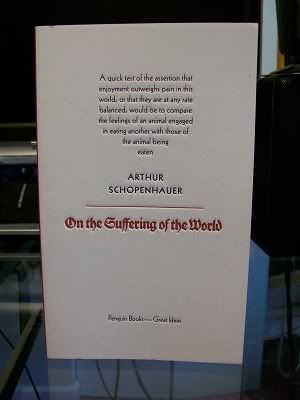
Shifting from Marx and Engels's ultimately positive work to what has thus far been the most depressing and inflammatory read of the Great Idea series. Arthur Schopenhauer's On The Suffering Of The World is a collection of the German philosopher's essays on varying topics, but one concept that runs central in all of the works is a statement he makes in the first essay, Schopenhauer states that all pain and suffering in the world is positive, due to the fact that they occur far more naturally and routinely than feelings of happiness and gratification, which he deems as negative due to the fact that they are simply the "mere abolition of desire and extinction of a pain". Through this lens he tackles everything from vanity, death, suicide and thinking to the subject of women.
His essay simply titled On Women is widely known as Schopenhauer's heavy handed attack on the fledgling feminism movement, along with a society that allows women that sort of power. In this work Schopenhauer exhibits what is perhaps one of the most ignorant things I have ever read, calling women everything from "the weaker sex" to his statement that "Neither for music, nor poetry, nor the plastic arts do they possess any real feeling or receptivity: if they affect to do so it is merely mimicry in service of their effort to please". You might be reading this and thinking "well it was the times, man", but if you read the entire essay you would realize that it's even a little extreme for the mid 19th century. However, this work has a train-wreck quality to it and in that sense that I'm glad it's still being published, it is still an incredibly interesting read, even if what he was saying did warrant a punch in the head. All in all, probably one of my favourite books of all time simply due to the variety (and intensity) of emotional responses it drew.
Magazines
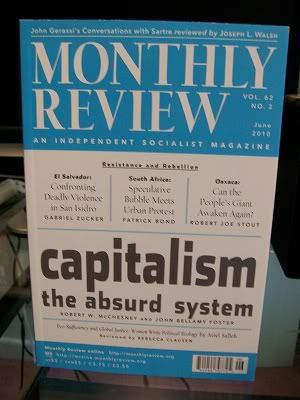
Jumping into magazines now, and keeping with the theme of the first book in this post, I was glad to pick up the next issue of Monthly Review, which happens to be Volume 62 Number 02. I enjoyed the last issue I read quite a bit but I still felt that this one was leaps and bounds better. This is probably due to the fact that the primary cover story, Capitalism, The Absurd System by Robert W. McChesney and John Bellamy Foster makes a statement that I (along with many others, I'm sure) can greatly appreciate and agree with, that being that there is no legitimate leftist option in the political arena. They applied it to the American political parties, but it applies even more so in Canada. They mention that the democratic party (and by default the NDP and Liberals, in Canada) are far too afraid of polarizing public opinion to drift even further left, along with the fact that drifting left eventually abandons Capitalism, which is apparently bad news for a political party. I agree whole heartedly, and this story plus all three other stories in this issue (regarding activist murders in El Savador, Urban protest to neoliberal policies in South Africa, and the sadly temporary revolutionary action in Oaxaca, Mexico) are just as great. Finally, this issue concludes with a book review titled Sartre: Conversations with a "Bourgeois Revolutionary", for John Gerassi's Talking with Sartre: Conversations and Debates, slightly hypocritical after my rant on conservative socialism, but c'est la vie. I'm not missing out on a chance to read Sartre himself discussing his political views, among other things.

Shifting a little in content with this one, McSweeney's Publishing does it again with the 72nd issue of their monthly magazine The Believer. Featuring an always eclectic assortment of articles ranging from the slow ongoing downfall of Freetown Christiana, an autonomous community in Denmark to an article by Michael G. Powell on the history of Sharpie permanent markers. The highlight for me, however was a great interview with KCW's Bookworm host Michael Silverblatt in which he explained how he got to the position he is in, what makes an interview great, and most amazing reveals that before he interviews an author he makes his absolute best attempt to read that author's entire body of work. A daunting task for sure, that is serious dedication on his part.
Also included is another great comics section edited by Alvin Buenaventura who sadly had to recently shut down his printing company, Buenaventura Press. I'm glad that he's still in charge of this though because they are great. And as usual, Nick Hornby amazes me with Stuff I've Been Reading, in which he amusingly rambles on about his life and things he's read. He's been raving about David Kynaston's Austerity Britain for two issues now, and it's really tempting me to go pick it up, despite the fact that it's apparently a massive book and the fact that I've never set foot in Britain. He talks it up real well, I gotta say. Oh, and Hornby went to the Oscars, which leads to an amusing tangent. Pick up this issue if you like to read....well anything really. If you like comics, poetry, interviews, books, history, useless facts, anything.

Finally in the trio of magazines from this batch of books is issue 36 of the great Canadian magazine Maisonneuve, a "quarterly of arts, opinion & ideas". Or as I like to call it, "the magazine that's good enough that I probably would have checked it out anyway but I think I just bought it for the Chris Ware comic". Seriously, I read a friend's copy of their last issue on a long bus ride a couple months back, and it was then that I realized that this is where Chris Ware has been hiding his comics lately, along with the fact that this magazine was from that point on on my "to buy" list.
But as I mentioned, this isn't a one trick pony either. This issue had two articles that were so full of Canadiana I could smell the maple syrup and back bacon a mile away. The first was a photo essay titled From Holyrood to Brigus by photographer Scott Walden, using photos from his series All the Clubs from Holyrood to Brigus, a series of club and legion hall photos from rural Newfoundland, and Newfoundlander poet Mary Dalton accompanies those photos with prose poems. Things like this make me almost feel depraved of growing up in southern Ontario. I feel like I'm missing out on the few things that give Canada it's unique cultural heritage (I know, it's more than Legion halls and dive bars, but there is no denying that they play a part). And on a more light hearted note, is The Eh-List, as writer John Semley sheds some light on the forgotten (or conveniently ignored) world of Canadian b-film, or as it is lovingly termed, Canuxploitation. All that I know is that just reading this article alone added a good dozen movies to my list of things I wanted to see, and then I did some digging and found this site. Thank you, John Semley, for devouring yet another chunk of my free time. These articles (and Chris Ware's EXCELLENT comic) are just the tip of the iceberg for this great (and inexpensive, sitting at $6.95 CDN) quarterly, if you never listen to anything else I say on here, do yourself a favour and read this.
Comics
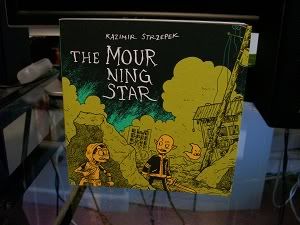
First of the comics is Kazimir Strzepek's The Mourning Star Vol.1, telling the story of a a trio trying to survive in a post-apocalyptic fantasy world. At first, I was a little apprehensive because I didn't know how I felt about the art style. I thought it was a little too Asian influenced for me, but as I read I think I came to terms with the fact that Manga, much like western cartooning can be awful or not awful, this falls into the latter. In addition to this, it has a great central cast of likable (for the most part) characters, and enough action and gore to keep someone like me entertained. Also, Strzepek created an entire alphabet for one of the tribes in this book to use, and included a tool to decipher it at the end of the book, which I thought fucking ruled and to be honest I think that's what really sold me on this book. This would be good if you like fantasy settings and adventure plots, and it was a nice break from the sort of comic I usually read.
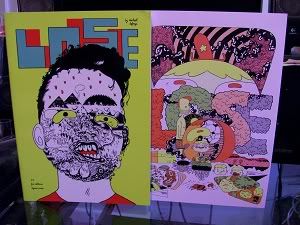
Speaking of "the sort of comic I usually read", I was really impressed with Toronto's Michael Deforge (who I know I've raved about before, so I'll save it this time) and the first two issues of his comic, titled Lose. Both of these are great, with a couple shorter strips included in each. The personal highlights for me were Dogs in College in the first issue, along with Cave Adventure from issue two, both being excellently drawn and hilarious. Really though, DeForge's drawing style alone was enough for me to pick these up, the fact that he just so happens to be great at writing funny strips is just an added bonus. Like comics? get this. Live in Toronto? get this. Hate everything? still get this.
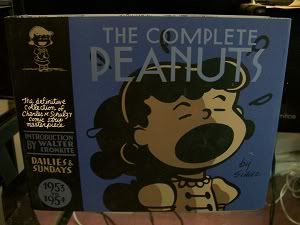
Next up is the second edition of Fantagraphics Books' The Complete Peanuts Collection, collecting every daily and Sunday strip from 1953-1954, plus a couple neat extras. Much like the first edition, this is laid out wonderfully, with an introduction by American journalist and anchorman Walter Cronkite that can only be described as "really cool". This volume also features the introduction of Pigpen, the Peanuts resident crust punk and one of my favourite characters. Also introduced Charlotte Braun, the short lived female counterpart to Charlie Brown, who's running joke was that she TALKED REALLY LOUD. I thought it was hilarious, but I guess Schulz didn't, considering he cut her from the strip so quickly.
This issue shows that Schulz was in full swing with the characters as opposed to the first couple of years where it was clear that he was getting his footing when it came to writing Charlie and the gang. If you can, pick up the box set of these two first volumes, it's something you don't want to miss.
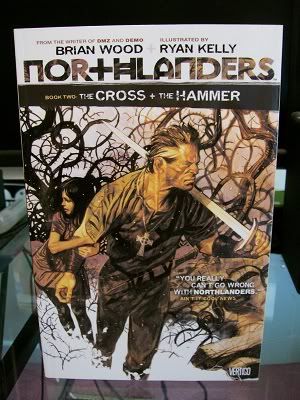
From some kids playing in their neighbourhood to pissed off Irishmen trying to keep invading Vikings off their land, this is the second collection of Brian Wood's Northlanders. I was a little surprised by the fact that this has an entirely different setting and cast of characters than the first book, but once I thought about it, considering this is a series about the impact of viking settlements in Europe as a whole. And besides, I like these characters even more.
Featuring an Irishman and his daughter Brigid, this comic has the most (and best) gore I've seen in a long time. The Irishman kills like the Punisher on speed, murdering anyone he stumbles across who he thinks invaded his country. I should have kept a tally of all the deaths as I read this, I imagine it's 50+, and they're all illustrated in wonderfully graphic detail. If you're into comics with a real loose historical background, superb art and tons of violence I don't know why you wouldn't get into this series.
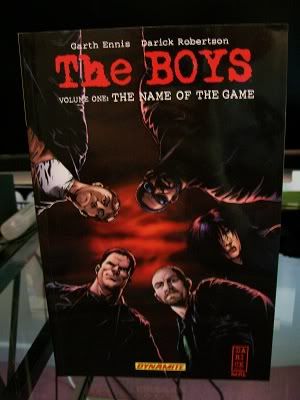
Speaking of comics with "mature themes", I picked up the first volume of Garth Ennis' The Boys, a story of a team of five humans who decide that they need to rid the world of superheros before they wise up and take over the world. Oh, and one of the characters is illustrated as British actor/writer Simon Pegg, just to up the stakes of weirdness a little.
I'm used to picking up comics with warnings about mature content and not really finding anything objectionable in them, but I was glad that I got the bang for my buck on this one. From the back cover illustration of a superhero getting his head stomped on pavement to the numerous sex scenes throughout the book it really did feel as gritty as it should have, and even to the point that I think Ennis would have been hard pressed to publish this material through Marvel (even the MAX imprint) just because of content. My only gripe is the art and colouring in specific, it's real clear that it a largely digital process, with the pictures looking airbrushed and cheesy. I'll give this another volume or two to see if it shapes up, but other than that I can't really see myself continuing on with this series, bummer too because I really enjoy the content.

Next up are a group of comics from Fantagraphics Books' Ignatz Series, a series of comics collected and edited by Italian artist Igort, all of them are a uniform size with really nice slipcovers and great stories. This is Ignatz #0, French artist David B.'s Babel issue 1. easily my favourite of the first four books of the series, Babel is a semi-autobiographical story of the artist mixed in with amazing dream sequences and other side stories. David B.'s art takes on a great almost primal feel because of the great use of simple movement and shapes paired with the fact that he was limited (as all Ignatz series artists are) to only three colours per book. I love the surreal feeling of this book, adn I'm looking forward to picking up number two as soon as I can.
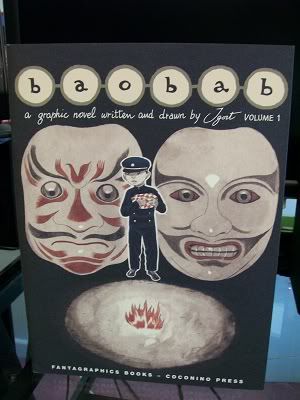
The official beginning to the Ignatz series is Igort's own contribution, Baobab issue 1. Much like Babel, this is a story focusing on a Japanese child Hirohsi learning about his family and imagining his own version of those stories. Meanwhile, in South America an older man, Celestino decides that he is gong to be a story teller and takes to drawing comics for a local newspaper. I feel like in future issues these two plots will converge and it will be really good. The art in this book is much more reserved than that of Babel, choosing to work only in pale blue watercolour and black Igort creates a style of art that looks both very conservative and regal when drawing the Japan scenes, but also has a great dreamlike quality when it comes to both Hiroshi's imagination and Celestino's comics. Excellent book, I'm also looking forward to getting the next issue of this.
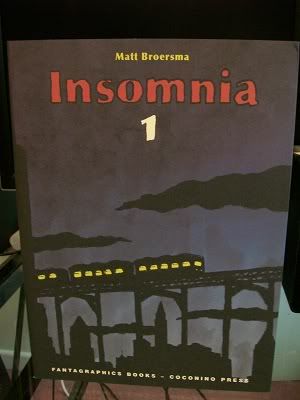
Next is Ignatz #2 with Matt Broersma's Insomnia issue one. A much more complicated narrative than either of the other two Ignatz titles so far, this opens up with a room full of slightly inebriated story-telling skeletons before it switches into the store which comprises the real meat of this issue, Eldorado. Telling the story of a fugitive making a mad dash to Mexico, Eldorado shows Dr. John Bentley getting into situations that may or may not include a drug dealer and a scene with a underwater macabre mariachi band, good stuff. Using a colour choice similar to that of Igort, Broersma's drawing is much sketchier than that of the Italian artist, leading to an art style that fits the mood of both stories contained here. Dark blues and black dominate every frame and it looks really full and dark, the intention, I'm sure. This is good, but compared to the other three of this batch I'm going to have to say that it's the weakest of the round.
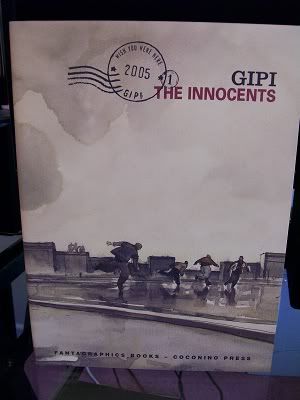
Closing out the last of these four Ignatz Series components is another Italian cartoonist, Gipi with the first issue of his series Wish You Were Here: The Innocents, telling the story of an uncle on an outing with his nephew as they decide to skip out on the original plan of going to an amusement park and opt to hangout with one of the Uncle's former gang buddies. I think this was my favourite of the four books in terms of story, it's great to see the uncle learning about ow to behave around his nephew, along with nephew's maturity towards the situations that unfold, great characters. Also, the art changes completely from the normal art to a real basic line drawing format for flashback scenes, a technique that seems to be running rampant throughout this series but one that continues to impress me, either way. I'm eager to read the next segment Gipi writes of this series.

From the highbrow to the lowbrow, here's issue two of Wowee Zonk published by the Toronto collective conveniently named Wowee Zonk. Feature work by great artists like Chris Kuzma, Michael Deforge (again), Patrick Kyle and more, this hodgepodge of different short strips is amazing, both in content and art style. From underwater sex to a repeating strip called Scrote which is just a floating head berating his life, this is sure to have something for everyone. And so it should. I'm not sure what else to say about this other than it fucking rules and if you don't believe me I think you should buy so I can prove you very wrong.
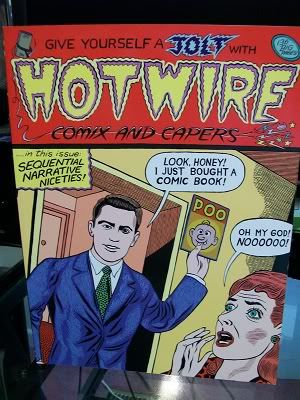
The final book in this ridiculous marathon of reviews is the first volume of Hotwire Comix and Capers, a collection of various artists put together and edited by Glenn Head. Along with a great cover by the hilarious Michael Kupperman. With a collection as large as this (39 works in total) there are bound to be ups and downs but I think this one has a greater quantity of the former. Great quality throughout, and I'm looking forward to picking up the other two volumes that have already been released. I can't think of anything else to say, my brain hurts.
Fin.

No comments:
Post a Comment